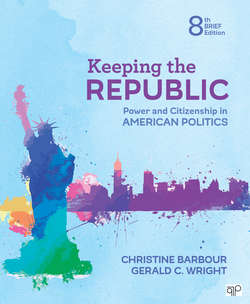Читать книгу Keeping the Republic - Christine Barbour - Страница 18
На сайте Литреса книга снята с продажи.
To The Student Suggestions on How to Read This Textbook
Оглавление1 As they say in Chicago about voting, do it early and often. If you open the book for the first time the night before the exam, you will not learn much from it and it won’t help your grade. Start reading the chapters in conjunction with the lectures, and you’ll get so much more out of class.
2 Pay attention to the chapter headings and In Your Own Words goals. They tell you what we think is important, what our basic argument is, and how all the material fits together. Often, chapter subheadings list elements of an argument that may show up on a quiz. Be alert to these clues.
3 Read actively. Constantly ask yourself: Why is this important? How do these different facts fit together? What are the broad arguments here? How does this material relate to class lectures? How does it relate to the broad themes of the class? When you stop asking these questions, you are merely moving your eyes over the page, and that is a waste of time.
4 Highlight or take notes. Some people prefer highlighting because it’s quicker than taking notes, but others think that writing down the most important points helps in recalling them later. Whichever method you choose (and you can do both), be sure you’re doing it properly.Highlighting. An entirely highlighted page will not give you any clues about what is important. Read each paragraph and ask yourself: What is the basic idea of this paragraph? Highlight that. Avoid highlighting all the examples and illustrations. You should be able to recall them on your own when you see the main idea. Beware of highlighting too little. If whole pages go by with no marking, you are probably not highlighting enough.Outlining. Again, the key is to write down enough, but not too much. Go for key ideas, terms, and arguments.
5 Note all key terms, and be sure you understand the definition and significance.
6 Do not skip tables and figures. These things are there for a purpose, because they convey crucial information or illustrate a point in the text. After you read a chart or graph or Big Picture infographic, make a note in the margin about what it means.
7 Do not skip the boxes. They are not filler! The Don’t Be Fooled by . . . boxes provide advice on becoming a critical consumer of the many varieties of political information that come your way. Each Profile in Citizenship box highlights the achievements of a political actor pertinent to that chapter’s focus. They model citizen participation and can serve as a beacon for your own political power long after you’ve completed your American government course. And the Snapshot of America boxes help you understand who Americans are and how they line up on all sorts of dimensions.
8 Make use of the book’s web site at http://edge.sagepub.com/barbourbrief8e. There you will find chapter summaries, flashcards, and practice quizzes that will help you prepare for exams.
